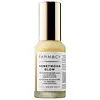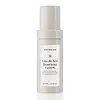What's inside
What's inside
 Key Ingredients
Key Ingredients

 Benefits
Benefits

 Concerns
Concerns

 Ingredients Side-by-side
Ingredients Side-by-side

Water
Skin ConditioningLactic Acid
BufferingPropanediol
SolventJojoba Esters
EmollientGlycolic Acid
BufferingPotassium Hydroxide
BufferingSalix Alba Bark Extract
AstringentCarthamus Tinctorius Oleosomes
EmollientVitis Vinifera Seed Oil
EmollientHibiscus Sabdariffa Flower Extract
Skin ConditioningCitric Acid
BufferingHoney Extract
HumectantEchinacea Purpurea Root Extract
MoisturisingPropolis Extract
Skin ConditioningRoyal Jelly Extract
Skin ConditioningHydrolyzed Sodium Hyaluronate
Skin ConditioningHydrolyzed Hyaluronic Acid
HumectantCurcuma Longa Root Extract
MaskingArgania Spinosa Kernel Oil
EmollientZingiber Officinale Root Extract
MaskingAmaranthus Caudatus Seed Oil
EmollientLimnanthes Alba Seed Oil
Skin ConditioningVaccinium Myrtillus Fruit/Leaf Extract
AstringentSaccharum Officinarum Extract
MoisturisingCitrus Aurantium Dulcis Fruit Extract
MaskingCitrus Limon Fruit Extract
MaskingAcer Saccharum Extract
Skin ConditioningMelia Azadirachta Leaf Extract
Skin ConditioningHelianthus Annuus Seed Oil
EmollientMelia Azadirachta Flower Extract
Skin ConditioningSalvia Hispanica Seed Oil
MoisturisingCetearyl Alcohol
EmollientGlycerin
HumectantArachidyl Alcohol
EmollientSclerotium Gum
Emulsion StabilisingCoco-Glucoside
CleansingPolyacrylate Crosspolymer-6
Emulsion StabilisingBehenyl Alcohol
EmollientArachidyl Glucoside
EmulsifyingSodium Benzoate
MaskingTocopherol
AntioxidantPotassium Sorbate
PreservativeCorallina Officinalis Extract
Skin ConditioningPolyglyceryl-10 Stearate
Skin ConditioningGluconolactone
Skin Conditioning1,2-Hexanediol
Skin ConditioningOcimum Basilicum Flower/Leaf Extract
TonicOcimum Sanctum Leaf Extract
Skin ConditioningT-Butyl Alcohol
PerfumingGlucose
HumectantCalcium Gluconate
HumectantCitral
PerfumingWater, Lactic Acid, Propanediol, Jojoba Esters, Glycolic Acid, Potassium Hydroxide, Salix Alba Bark Extract, Carthamus Tinctorius Oleosomes, Vitis Vinifera Seed Oil, Hibiscus Sabdariffa Flower Extract, Citric Acid, Honey Extract, Echinacea Purpurea Root Extract, Propolis Extract, Royal Jelly Extract, Hydrolyzed Sodium Hyaluronate, Hydrolyzed Hyaluronic Acid, Curcuma Longa Root Extract, Argania Spinosa Kernel Oil, Zingiber Officinale Root Extract, Amaranthus Caudatus Seed Oil, Limnanthes Alba Seed Oil, Vaccinium Myrtillus Fruit/Leaf Extract, Saccharum Officinarum Extract, Citrus Aurantium Dulcis Fruit Extract, Citrus Limon Fruit Extract, Acer Saccharum Extract, Melia Azadirachta Leaf Extract, Helianthus Annuus Seed Oil, Melia Azadirachta Flower Extract, Salvia Hispanica Seed Oil, Cetearyl Alcohol, Glycerin, Arachidyl Alcohol, Sclerotium Gum, Coco-Glucoside, Polyacrylate Crosspolymer-6, Behenyl Alcohol, Arachidyl Glucoside, Sodium Benzoate, Tocopherol, Potassium Sorbate, Corallina Officinalis Extract, Polyglyceryl-10 Stearate, Gluconolactone, 1,2-Hexanediol, Ocimum Basilicum Flower/Leaf Extract, Ocimum Sanctum Leaf Extract, T-Butyl Alcohol, Glucose, Calcium Gluconate, Citral
Water
Skin ConditioningGlycolic Acid
BufferingPropanediol
SolventSodium Hydroxide
BufferingGlycerin
HumectantPolyacrylate Crosspolymer-11
Emulsion StabilisingVaccinium Myrtillus Fruit/Leaf Extract
AstringentSaccharum Officinarum Extract
MoisturisingCitrus Aurantium Dulcis Fruit Extract
MaskingCitrus Limon Fruit Extract
MaskingAcer Saccharum Extract
Skin ConditioningMicrocitrus Australis Fruit Extract
Skin ConditioningSodium Hyaluronate
HumectantHydroxyacetophenone
AntioxidantPhenoxyethanol
PreservativeHydroxyethylcellulose
Emulsion StabilisingTocopheryl Acetate
AntioxidantEthylhexylglycerin
Skin ConditioningDisodium EDTA
Tocopherol
AntioxidantWater, Glycolic Acid, Propanediol, Sodium Hydroxide, Glycerin, Polyacrylate Crosspolymer-11, Vaccinium Myrtillus Fruit/Leaf Extract, Saccharum Officinarum Extract, Citrus Aurantium Dulcis Fruit Extract, Citrus Limon Fruit Extract, Acer Saccharum Extract, Microcitrus Australis Fruit Extract, Sodium Hyaluronate, Hydroxyacetophenone, Phenoxyethanol, Hydroxyethylcellulose, Tocopheryl Acetate, Ethylhexylglycerin, Disodium EDTA, Tocopherol
Ingredients Explained
These ingredients are found in both products.
Ingredients higher up in an ingredient list are typically present in a larger amount.
We don't have a description for Acer Saccharum Extract yet.
Citrus Aurantium Dulcis Fruit Extract is more commonly known as the bitter orange. Native to Southeast Asia, this extract is commonly found in both cosmetics and foods.
The bitter orange possesses antibacterial and antioxidant properties.
It can also be mildly exfoliating due to the citric acid, an AHA.
Citrus fruits are rich in flavonoids, alkaloids, and vitamin C.
Learn more about Citrus Aurantium Dulcis Fruit ExtractCitrus Limon Fruit Extract comes from lemons. While lemon extract is exfoliating and antimicrobial, it can also cause skin sensitivity.
Lemons contains antioxidants, which may help with anti-aging. They are also rich in citric acid, an AHA.
And of course, lemons are rich in Vitamin C. Vitamin C helps with skin-brightening and increasing collagen production.
The acidity of lemons may work as an astringent for acne.
However, lemons can also cause skin sensitivity due to its limonene content. It can also increase photosensitivity, or sensitivity to the sun.
This ingredient is also used to add a lemon scent to products.
Learn more about Citrus Limon Fruit ExtractGlycerin is already naturally found in your skin. It helps moisturize and protect your skin.
A study from 2016 found glycerin to be more effective as a humectant than AHAs and hyaluronic acid.
As a humectant, it helps the skin stay hydrated by pulling moisture to your skin. The low molecular weight of glycerin allows it to pull moisture into the deeper layers of your skin.
Hydrated skin improves your skin barrier; Your skin barrier helps protect against irritants and bacteria.
Glycerin has also been found to have antimicrobial and antiviral properties. Due to these properties, glycerin is often used in wound and burn treatments.
In cosmetics, glycerin is usually derived from plants such as soybean or palm. However, it can also be sourced from animals, such as tallow or animal fat.
This ingredient is organic, colorless, odorless, and non-toxic.
Glycerin is the name for this ingredient in American English. British English uses Glycerol/Glycerine.
Learn more about GlycerinGlycolic Acid is arguably the most famous alpha hydroxy acid (AHA) with tons of research backing its benefits.
It is found naturally in sugar cane but the form used in skincare is usually synthetic for purity and stability.
Glycolic acid removes the top layer of dead skin cells to allow newer and fresher ones to emerge.
AHAs work by breaking down the structural “glue” that holds old skin cells in place. When that buildup is gone, your skin can renew itself more efficiently.
Research also shows glycolic acid stimulates collagen production, helping to firm and thicken the skin over time. This is one of its biggest advantages over other AHAs.
Overall, glycolic acid helps with:
Fun fact: Glycolic acid boosts skin hydration by helping it produce molecules that increase hyaluronic acid naturally.
To work best, glycolic acid products should have a pH between 3-4 (that’s where exfoliation is most effective but still gentle on skin).
The pH and concentration of a product are key to its effectiveness:
It is normal to feel a slight stinging sensation when using glycolic acid. This usually fades as your skin adjusts.
Because glycolic acid has the smallest molecular size in the AHA family, it can penetrate deeper, which enhances its effectiveness but also makes it more likely to irritate sensitive skin.
If your skin is very sensitive or prone to rosacea, glycolic acid may be too strong; in that case, try milder options like lactic acid or a PHA instead.
Recent studies suggest glycolic acid might even help protect against UV damage. But don’t skip sunscreen! Freshly exfoliated skin is more sensitive to the sun.
Glycolic acid is a skincare superstar. It smooths, brightens, hydrates, and firms the skin. Unless you’re highly sensitive, it’s well worth adding to your routine.
Read more about some other popular AHA's here:
Learn more about Glycolic AcidPropanediol is an all-star ingredient. It softens, hydrates, and smooths the skin.
It’s often used to:
Propanediol is not likely to cause sensitivity and considered safe to use. It is derived from corn or petroleum with a clear color and no scent.
Learn more about PropanediolThis ingredient is also called sugarcane extract. It is a moisturizing humectant and has skin soothing properties.
Similar to hyaluronic acid, sugarcane can attract moisture to your skin.
Glycolic acid is a derivative of sugarcane. While glycolic acid is an AHA with exfoliating properties, sugarcane is not an AHA.
A study from 2021 found the compounds in sugarcane extract to have antioxidant, antimicrobial, and anti-inflammatory activity. The study also suggests these compounds can inhibit skin ageing enzymes and promote collagen synthesis.
Learn more about Saccharum Officinarum ExtractTocopherol (also known as Vitamin E) is a common antioxidant used to help protect the skin from free-radicals and strengthen the skin barrier. It's also fat soluble - this means our skin is great at absorbing it.
Vitamin E also helps keep your natural skin lipids healthy. Your lipid skin barrier naturally consists of lipids, ceramides, and fatty acids. Vitamin E offers extra protection for your skin’s lipid barrier, keeping your skin healthy and nourished.
Another benefit is a bit of UV protection. Vitamin E helps reduce the damage caused by UVB rays. (It should not replace your sunscreen). Combining it with Vitamin C can decrease sunburned cells and hyperpigmentation after UV exposure.
You might have noticed Vitamin E + C often paired together. This is because it is great at stabilizing Vitamin C. Using the two together helps increase the effectiveness of both ingredients.
There are often claims that Vitamin E can reduce/prevent scarring, but these claims haven't been confirmed by scientific research.
Learn more about TocopherolWe don't have a description for Vaccinium Myrtillus Fruit/Leaf Extract yet.
Water. It's the most common cosmetic ingredient of all. You'll usually see it at the top of ingredient lists, meaning that it makes up the largest part of the product.
So why is it so popular? Water most often acts as a solvent - this means that it helps dissolve other ingredients into the formulation.
You'll also recognize water as that liquid we all need to stay alive. If you see this, drink a glass of water. Stay hydrated!
Learn more about Water